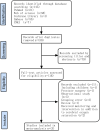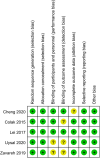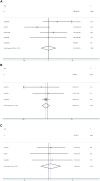Effect of near-infrared spectroscopy on postoperative delirium in cardiac surgery with cardiopulmonary bypass: a systematic review and meta-analysis
- PMID: 38962088
- PMCID: PMC11221214
- DOI: 10.3389/fcvm.2024.1404210
Effect of near-infrared spectroscopy on postoperative delirium in cardiac surgery with cardiopulmonary bypass: a systematic review and meta-analysis
Abstract
Background: Postoperative delirium (POD) is a common anesthetic side effect in cardiac surgery. However, the role of oxygen saturation monitoring in reducing postoperative delirium has been controversial. Therefore, this meta-analysis aimed to analyze whether NIRS monitoring during cardiac surgery under cardiopulmonary bypass could reduce the incidence of postoperative delirium.
Methods: PubMed, Web of Science, Cochrane Library, Embase and China National Knowledge Infrastructure (CNKI) databases were systematically searched using the related keywords for randomized-controlled trials (RCTs) published from their inception to March 16, 2024. This review was conducted by the Preferred Reporting Project and Meta-Analysis Statement (PRISMA) guidelines for systematic review. The primary outcome was postoperative delirium, and the second outcomes included the length of ICU stay, the incidence of kidney-related adverse outcomes, and the incidence of cardiac-related adverse outcomes.
Results: The incidence of postoperative delirium could be reduced under the guidance of near-infrared spectroscopy monitoring (OR, 0.657; 95% CI, 0.447-0.965; P = 0.032; I2 = 0%). However, there were no significant differences in the length of ICU stay (SMD, 0.005 days; 95% CI, -0.135-0.146; P = 0.940; I2 = 39.3%), the incidence of kidney-related adverse outcomes (OR, 0.761; 95% CI, 0.386-1.500; P = 0.430; I2 = 0%), and the incidence of the cardiac-related adverse outcomes (OR, 1.165; 95% CI, 0.556-2.442; P = 0.686; I2 = 0%) between the two groups.
Conclusion: Near-infrared spectroscopy monitoring in cardiac surgery with cardiopulmonary bypass helps reduce postoperative delirium in patients.
Systematic review registration: PROSPERO, identifier, CRD42023482675.
Keywords: cardiac surgery; cardiopulmonary bypass; cerebral oxygen saturation; meta-analysis; near-infrared spectroscopy; postoperative delirium.
© 2024 Sun and Wu.
Conflict of interest statement
The authors declare that the research was conducted in the absence of any commercial or financial relationships that could be construed as a potential conflict of interest.
Figures






Similar articles
-
The Effect of Intraoperative Cerebral Oximetry Monitoring on Postoperative Cognitive Dysfunction and ICU Stay in Adult Patients Undergoing Cardiac Surgery: An Updated Systematic Review and Meta-Analysis.Front Cardiovasc Med. 2022 Feb 1;8:814313. doi: 10.3389/fcvm.2021.814313. eCollection 2021. Front Cardiovasc Med. 2022. PMID: 35178431 Free PMC article.
-
Outcomes of postoperative delirium in patients undergoing cardiac surgery: A systematic review and meta-analysis.Front Cardiovasc Med. 2022 Aug 9;9:884144. doi: 10.3389/fcvm.2022.884144. eCollection 2022. Front Cardiovasc Med. 2022. PMID: 36017087 Free PMC article.
-
Effects of Glucocorticoids on Postoperative Delirium in Adult Patients Undergoing Cardiac Surgery: A Systematic Review and Meta-analysis.Clin Ther. 2021 Sep;43(9):1608-1621. doi: 10.1016/j.clinthera.2021.07.021. Epub 2021 Sep 20. Clin Ther. 2021. PMID: 34548175
-
Effects of electroencephalography and regional cerebral oxygen saturation monitoring on perioperative neurocognitive disorders: a systematic review and meta-analysis.BMC Anesthesiol. 2020 Sep 30;20(1):254. doi: 10.1186/s12871-020-01163-y. BMC Anesthesiol. 2020. PMID: 32998697 Free PMC article.
-
Incidence of delirium after non-cardiac surgery in the Chinese elderly population: a systematic review and meta-analysis.Front Aging Neurosci. 2023 Jun 29;15:1188967. doi: 10.3389/fnagi.2023.1188967. eCollection 2023. Front Aging Neurosci. 2023. PMID: 37455941 Free PMC article.
References
Publication types
LinkOut - more resources
Full Text Sources

